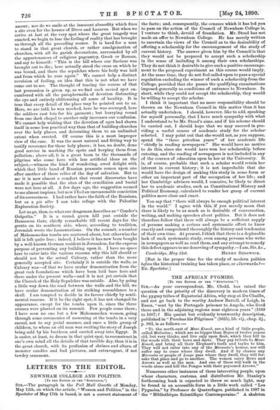THE AFRICAN PYG1WT1S.
[TO THE EDITOR OP THE " SPECTATOR...1
&Eq.—AS your correspondent, Mr. Clodd, has raised the question of the priority of the discovery in modern times of the pygmy tribes of Equatorial Africa, why stop at Du Chaffin,
and not go back to the worthy Andrew Battell, of Leigh, in Essex, "sent by the Portugals prisoner to Angola, who lived
there and in the adjoining regions near eighteen years" (1589,
to 1607) ? His quaint but evidently trustworthy description,. published in " Purchas his Pilgiimes " (1625), lib. vij., chap.
p. 983, is as follows :—
" To the north-east of Mani Kesock, are a kind of little people, called Matimbas ; which are no bigger than Boyes of twelve yeares old, but very thicke, and live only upon flesh, which they kill inx the woods with their bows and darts. They pay tribute to Mani- Sesock, and bring all their Elephant's teeth and tayles to him. They will not enter into any of the Maramba's houses, nor will suffer any to come where they dwell. And if by chance any Maramba or people of Longo pass where they dwell, they will for- sake that place and go to another. The women carry Bows and Arrows as well as the men. And one of these will walk in the woods alone and kill the Bongos with their poysoned Arrows."
Numerous other instances of these interesting people, upon whose characters, customs, and distribution Mr. Stanley's forthcoming book is expected to throw so much light, may be found in an accessible form in a little work called "Lea Pygmees," by Professor de Quatrefages, published in 1887 in the " Bibliotheque Scientifique Contemporaine." A skeleton of one of the tribe, called "Akita," sent about three years ago by Emin Pasha, is exhibited in the Osteological Gallery of this Museum. Although of a full-grown person, it does not exceed



































 Previous page
Previous page